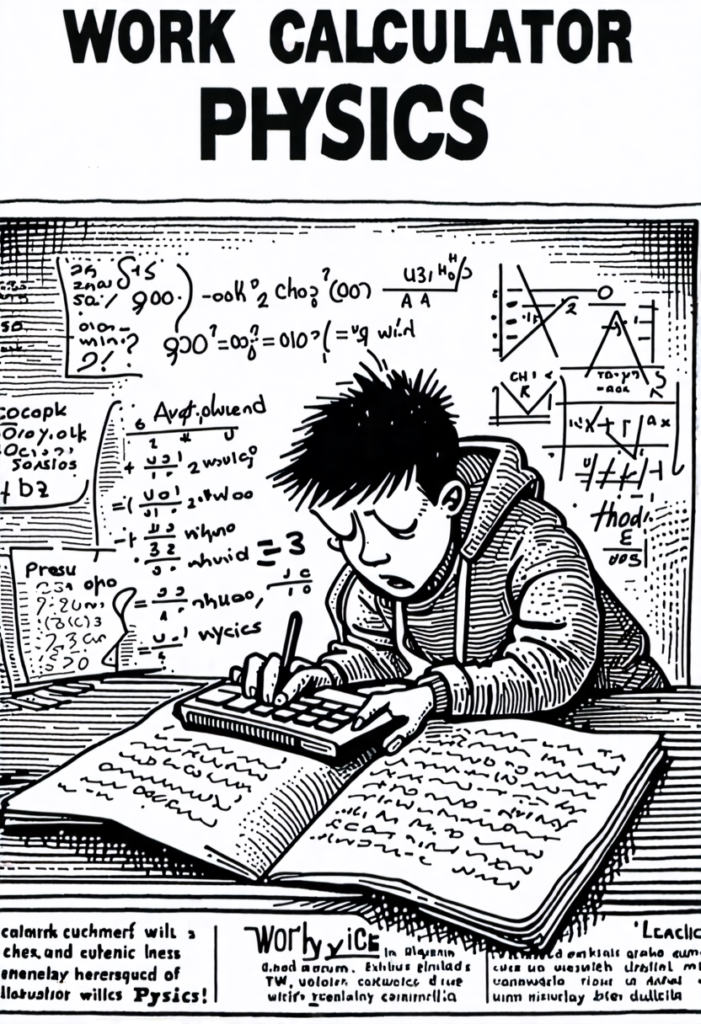Work Calculator Physics
The work calculator helps you calculate the work in joules from velocity change and from force and displacement.
To calculate work from velocity change, enter the object’s mass, initial speed, and final speed.
To calculate work from force and displacement, enter the force in Newtons and displacement in meters.
Work is a measure of energy transfer that occurs when a force pushes an object over a distance. If the force is constant, multiply the path length by its component to determine work. W = fd is the mathematical formula for work.
To calculate work from velocity change, we use this formula:
W=F×d=m/2×(v1^2−v0^2)

You might want to calculate the relationship between charged particles or find Charles’s law parameters.
What is Work in Physics?
Work, in physics terms, is defined as the product of force applied to an object and the distance the object moves in the direction of that force. It’s a measure of energy transfer that occurs when a force acts upon an object to cause a displacement. The formula for work is:
W = F × d
Where:
- W represents work (measured in joules, J)
- F represents force (measured in newtons, N)
- d represents displacement (measured in meters, m)
It’s important to note that work is a scalar quantity, meaning it has magnitude but no direction. The SI unit of work is the joule (J), which is equivalent to one newton-meter (N·m).
The Importance of Work Calculators in Physics
Work calculators are invaluable tools for students, educators, and professionals in fields related to physics and engineering. These calculators simplify the process of determining work done in various scenarios, allowing users to input known variables and quickly obtain results. Here are some key reasons why work calculators are essential:
- Accuracy: Work calculators minimize human error in calculations, providing precise results.
- Time-saving: They perform complex calculations instantly, saving valuable time for analysis and interpretation.
- Versatility: Many work calculators can handle different scenarios and variables, making them adaptable to various problems.
- Educational value: Students can use these tools to verify their manual calculations and gain a better understanding of the work concept.
How to Use our Work Calculator
Using our work calculator involves the following steps:
- Identify the known variables in your problem (force, distance, or work).
- Choose the appropriate calculation method based on the available information.
- Input the known values into the calculator.
- Click the “Calculate” button to obtain the result.
- Interpret the result in the context of your problem.
Let’s explore two common scenarios where a work calculator can be particularly useful.
Example 1: Calculating Work from Force and Displacement
Suppose you want to calculate the work done when pushing a heavy box across a room. You know the following information:
- Applied force: 50 N
- Displacement: 3 m
To use the work calculator:
- Select the “Force and Displacement” option in the calculation method.
- Enter 50 in the “Force (N)” field.
- Enter 3 in the “Displacement (m)” field.
- Click “Calculate.”
The calculator will display the result: Work (W) = 150 J
This means that 150 joules of work were performed in moving the box.
Example 2: Calculating Work from Velocity Change
In some cases, you might need to calculate work based on an object’s change in velocity. For instance, consider a car accelerating from rest to a certain speed. You have the following information:
- Mass of the car: 1500 kg
- Initial velocity: 0 m/s
- Final velocity: 20 m/s
To use the work calculator for this scenario:
- Select the “Velocity Change” option in the calculation method.
- Enter 1500 in the “Mass (m)” field.
- Enter 0 in the “Initial Speed (v₀)” field.
- Enter 20 in the “Final Speed (v₁)” field.
- Click “Calculate.”
The calculator will display the result: Work (J) = 300,000 J
This indicates that 300,000 joules of work were done to accelerate the car from rest to 20 m/s.
Understanding the Work Formula
The work formula, W = F × d, is the foundation of work calculations in physics. Let’s break down its components:
- Force (F): This is the amount of push or pull applied to an object, measured in newtons (N).
- Distance (d): This represents the displacement of the object in the direction of the applied force, measured in meters (m).
It’s crucial to understand that work is only done when there is a displacement in the direction of the applied force. If a force is applied perpendicular to the motion of an object, no work is done.
Factors Affecting Work Calculations
Several factors can influence work calculations:
- Angle of force application: When force is applied at an angle to the direction of motion, only the component of force parallel to the displacement contributes to work.
- Varying force: If the applied force changes over the displacement, the work done must be calculated using calculus or approximated by breaking the motion into smaller segments.
- Friction: In real-world scenarios, friction often opposes motion and affects the net work done on an object.
- Gravitational potential energy: When an object moves vertically, work is done against or by gravity, affecting the total work calculation.
Applications of Work Calculators
Work calculators find applications in various fields:
- Physics education: Students use these tools to verify their manual calculations and gain intuition about work and energy concepts.
- Engineering: Engineers use work calculators to design machines, determine power requirements, and optimize energy efficiency.
- Sports science: Analysts calculate the work done by athletes to improve training regimens and performance.
- Construction: Planners use work calculations to determine the energy requirements for moving materials and operating machinery.
- Automotive industry: Engineers calculate the work done by engines and braking systems to improve vehicle performance and efficiency.
Limitations of Work Calculators
While work calculators are powerful tools, it’s important to recognize their limitations:
- Simplification: Most calculators assume ideal conditions and may not account for real-world factors like friction or air resistance.
- Context: Calculators provide numerical results but don’t interpret the physical significance of the work done.
- Complex scenarios: Some situations involving non-uniform forces or complex motions may require more advanced calculators or analytical methods.
- Unit consistency: Users must ensure they input values in the correct units to avoid errors in calculations.

References
- O. (n.d.). 7.1 Work: The Scientific Definition – College Physics. 7.1 Work: The Scientific Definition – College Physics. pressbooks.uiowa.edu/clonedbook/chapter/work-the-scientific-definition/
- 9.1 Work, Power, and the Work–Energy Theorem – Physics | OpenStax. (n.d.). 9.1 Work, Power, and the Work–Energy Theorem – Physics | OpenStax. openstax.org/books/physics/pages/9-1-work-power-and-the-work-energy-theorem





